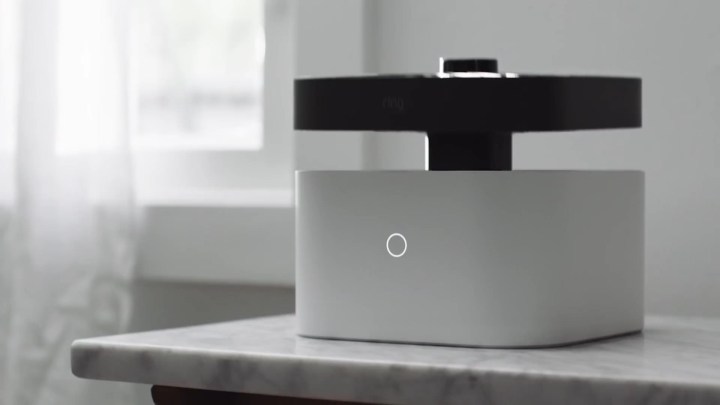Ah yes, we all knew the day would come when near-sentient flying drones could be piloted around our homes, serving our every need. Like all things tech, though, the future tends to land faster than we think. Ring, the Amazon-owned smart security company known for its video doorbells, floodlights, and cameras, is taking to the skies with the upcoming release of the Always Home Cam, a security drone that responds to Ring Alarm motion triggers.
During your initial setup of the Always Home, you’ll use the Ring app to build pre-determined flight paths that the drone will glide along when it leaves its charging dock. Once airborne, you’ll receive a notification on your mobile device, allowing you to pull up live video of whatever your Always Home has its sights on. Real-time footage streams in 1400 x 1400 HD video, and rest assured about your treasured home decor, for there’s plenty of object-avoidance tech loaded into the drone to keep it away from walls, furniture, and other valuables.
The Always Home Cam is an exciting addition to Ring’s pantheon of products, but does it make sense for the average joe to invest in one of these flying guardians? That depends, but here are a few thinking points to mull over while you think about getting added to Ring’s Always Home Cam invite list.
Consider your floor-plan
Do you live in an average 900-square-foot, single-story ranch? This kind of residential layout seems pretty perfect for the Always Home to traverse. Let’s say one of your Ring motion sensors is triggered at one end of your home, and the Always Home is located at the other end. That 900 square feet and single story aren’t too much real estate to cover. Assuming the Always Home can dart along at a decent clip, it should be able to get to the other end of the home to get whatever woke it on-camera.
That being said, homes with much larger floor plans and multiple floors may not be such an easy feat. Yes, once triggered, the Always Home starts recording footage through its entire flight path, but if a break-in is taking place on the first floor of your home and your Always Home is upstairs, it will inevitably take longer to get out of the room it’s located in, down the stairs, and to wherever the trigger was initiated.
That’s not to say that it shouldn’t be used in homes with larger layouts, but for bigger residences, it may make more sense to combine the Always Home with other surveillance cameras. A house with a smaller floor plan could probably get by with just the Always Home Cam.
What happens when the power goes out?
Unlike other Ring products with built-in batteries, the Always Home Cam relies on its charge dock to get juiced up between flights. That means that in the event of a power failure, the drone will still be able to operate, but for a limited time only. And with only five minutes of air time — and two hours for a full recharge — the Always Home isn’t designed to be in-flight for very long in the first place. In many ways, the drone is best-suited for the kind of emergency, motion-triggered events that will see the Always Home gliding and re-docking within three minutes or less.
But back to the overall power-loss conversation: Sure, the network handshake that the Always Home shares with its charging dock should tell the drone to return back to its base when power is running low, which eliminates the worry of it suddenly powering off mid-flight. However, Ring hasn’t disclosed yet what exactly will happen if for some reason it can’t dock.
While it’s tough to say exactly how Ring might handle such Mother Nature-driven occurrences, it would be wise for the company to include some kind of failsafe function for when the power is down. Many home security products are designed to work in the event of a power/service interruption.
What will the next generation bring?
The Always Home Cam is a brand new product, and while it’s plenty promising, there’s no escaping the fact that there will likely be a number of first-generation issues to tackle. While common bugs and glitches can be quickly handled with a software update or two, Ring may opt to completely redesign parts of the Always Home’s physical body, motor, camera, or other core peripherals once the company sees how homeowners take to the first-gen iteration.
Furthermore, Ring has been fairly transparent about the ways it plans to keep user privacy under wraps. Part of this protection is fundamentally covered by the Always Home’s charging dock, which intentionally obscures the camera lens when the drone is docked. But how will video streams and Ring app data be encrypted?
What about the competition?
While the surveillance drone marketplace offers plenty of outdoor options, Ring currently stands on a hill mostly all its own when it comes to indoor drone monitoring. Right now, drones like Sunflower Labs’ the Bee are the major foes to Ring’s Always Home Cam. Offering a grand suite of navigation features, indoor/outdoor versatility, and 15 minutes of runtime (compared to the Always Home’s minimal five minutes), the Bee brings impressive tech to the picture, but for the head-spinning price of $10,000.
There are plenty of surveillance drones on the market, but the prices are more aligned with the above-mentioned five-figure deal. One of the best things about the Always Home Cam is that it makes drone security affordable for the average consumer. Plus, if you’ve already got a Ring security system, being able to add the Always Home as another part of the Ring ecosystem will allow you to build an overall stronger smart security system.
The verdict
Without taking the Always Home Cam for a spin, it’s tough to say exactly how well the drone works and whether or not it makes sense for the typical family to purchase. But for what we’ve seen so far, we’re confident in going with a solid (and single) thumb-up for the time being. The price is right, the promised tech is solid, and adding a mobile layer to an existing Ring system is a great idea.
Once the Ring Always Home Cam hits the market, perhaps we’ll return to raise a second thumb-up (or lower the first). Stay tuned.





